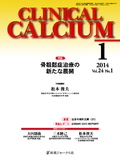Japanese
English
- 有料閲覧
- Abstract 文献概要
- 1ページ目 Look Inside
- 参考文献 Reference
ビスホスホネート(BP)製剤は,経口製剤として処方されることが多いが,その生物学的利用率は極めて低く1%にも満たない。しかも,アドヒアランスが悪い場合には十分な骨折抑制効果が期待できない。これらの問題を解決するために,静注で間歇投与するBP製剤が開発されてきた。現在,わが国では,アレンドロネートとイバンドロネートの静注製剤が使用できるが,年1回の投与でも効果があるゾレドロン酸静注製剤の適用も待たれている。これまでの臨床試験において,これらの静注BP製剤は十分な骨折抑制効果を示しており,経口BP製剤に対する非劣性も証明されている。静注BP製剤は,消化管障害や座位困難などにより,経口BP製剤が制限される患者に最も良い適応がある。
Bisphosphonates(BPs)are prescribed most frequently in an oral formulation. However, they have very limited bioavailability, and less than 1% of BPs administered orally are absorbed. In addition, poor adherence to oral BPs has been shown to be associated with suboptimal fracture reduction and prevention. Therefore, intravenous BP regimens have been developed to address this issue. In Japan, intermittent intravenous administration of alendronate and ibandronate on a monthly basis is currently available, and intravenous zoledronate on a yearly basis is expected to be available in the near future. Data have shown that intravenous BPs are noninferior to oral BPs in preventing osteoporotic fractures. Furthermore, intravenous BP administration is particularly advantageous in patients who do not tolerate or adhere to oral BPs, including those with gastrointestinal pathology, polypharmacy, or the inability to remain upright.



